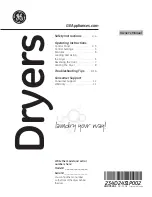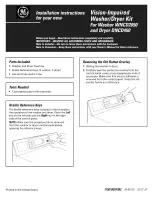
ENGLISH
ENGLISH
GB-25
GB-24
Amount of Detergent to Use
Push latch to open
NOTE:
NOTE:
WARNING!
•
If the lid is closed: press release button. The lid will spring open.
•
Always add the detergent just before starting each wash cycle.
•
Only use branded detergent aid for dishwasher.
•
You find information about the amount of detergent for the single programme on
the last page.
•
Please aware, that according to the level soiling and the specific hardness of water
differences are possible.
•
Please observe the manufacturer's recommendations on the detergent packaging.
•
Dishwasher detergent is corrosive!
•
Take care to keep it out of reach of children.
Fill in Detergent
Fill the detergent dispenser with detergent.
The marking indicates the dosing levels, as illustrated on
the right:
The place of main wash cycle detergent placed.
The place of pre-wash cycle detergent placed.
Please observe the manufacturers dosing and storage
Recommendations as stated on the detergent packaging.
Close the lid and press until it locks in place.
If the dishes are heavily soiled, place an additional detergent dose in the pre-wash
detergent chamber. This detergent will take effect during the pre-wash phase.
LOADING THE DISHWASHER BASKETS
(For best performance of the dish washer, follow these loading guidelines.
Features and appearance of baskets and cutlery baskets may vary from your model.)
Scrape off any large amounts of leftover food. Soften remnants of burnt food in pans.
It is not necessary to rinse the dishes under running water.
Place objects in the dishwasher in following way:
1.
Items such as cups, glasses, pots/pans, etc. are faced downwards.
2.
Curved items, or ones with recesses, should be loaded aslant so that water can run off.
3.
All utensils are stacked securely and cannot tip over.
4.
All utensils are placed in the way that the spray arms can rotate freely during washing.
Are not suitable
•
Cutlery with wooden, horn china or mother-of-pearl handles
•
Plastic items that are not heat resistant
•
Older cutlery with glued parts that are not temperature resistant
•
Bonded cutlery items or dishes
•
Pewter or cooper items
•
Crystal glass
•
Steel items subject to rusting
•
Wooden platters
•
Items made from synthetic fibres
Are of limited suitability
•
Some types of glasses can become dull after a large number of washes
•
Silver and aluminum parts have a tendency to discolour during washing
•
Glazed patterns may fade if machine washed frequently
•
Consider buying utensils which are identified as dishwasher-proof.
•
Use a mild detergent that is described as 'kind to dishes'. If necessary, seek further
information from the detergent manufacturers.
•
For particular items, select a program with as low a temperature as possible.
•
To prevent damage, do not take glass and cutlery out of the dishwasher
immediately after the programme has ended.
Recommendation
For washing in the dishwasher the following cutlery/dishes
Attention before or after loading the Dishwasher Baskets













































